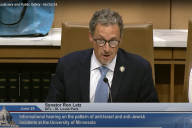You have /5 articles left.
Sign up for a free account or log in.
As some 17 million college students begin fall semester, "access" is front and center on people's minds. Countless reports and commentaries argue that spiraling tuition is making college less affordable, particularly citing costs in our public universities, and therefore limiting access for qualified applicants. Affordability is an important concern, to be sure.
But with so much attention drawn to college access or, more accurately, financial access, a broader, more insidious problem -- let's call it educational access -- lingers in the shadows, garnering less discussion. Preserving our nation's civic and economic health requires us to recognize, and then address, this hidden crisis.
The cost of college is significant for many students and families. Education officials understand this, and are working to make sufficient aid available. Even so, for the vast majority of students, the sacrifice will pay off handsomely. Notwithstanding the substantial societal benefits of an educated citizenry, college graduates themselves will earn 70 percent more, on average, than high school graduates, and generally enjoy better health outcomes and connections to supportive communities.
Despite these benefits, far too many students graduate high school unprepared for higher education, and a startling number simply don't graduate from high school at all. For these students, financial affordability is not a genuine barrier to college; no amount of financial aid and remedial help will make up for the inadequacy of the skills and experience needed to benefit fully from postsecondary education.
How do we know the system is in bad repair? High school on-time graduation rates -- hovering below 70 percent nationwide -- have been stagnant for two decades. And according to the National Center for Higher Education Management Systems, for every 100 young people who enter 9th grade, less than one-fifth will receive either an associate or bachelor's degree within 150 percent of the expected time.
Numbers are far worse for students from underrepresented minorities. Only 7 percent of Hispanic men and 15 percent of African-American men earn a college degree by age 29, as compared to the national average of over 28 percent. Today, only 8 percent of all students from families in the bottom quarter of income will ever get a four-year degree, whereas the top quartile sees a 75 percent college graduation rate.
Aside from the cost to individuals, it's not clear we have begun to acknowledge the societal cost of this crisis, or appreciate how the United States, already short on the knowledge workers that drive today's economy, will compete globally when roughly one-third of our students don't even earn a traditional high school diploma. We must, because if the trend persists, our national prosperity is in peril.
Ideally, college should be part of an education continuum, a "pipeline" that begins in childhood. In many of our nation's public schools, however, the pipeline is broken. Success will come only when all education sectors advance a common mission to prepare young people for citizenship and economic success, and then build a seamless pipeline to take them there.
One piece of a solution is for institutions of higher education -- especially our public universities, where service to the community is part of the mission -- to work with educators to strengthen the pre-K-16 pipeline. There are, as well, important roles for the private sector and community organizations. A positive first step, for example, could be a landmark national summit that convenes leaders from all of these groups to define the crisis and agree on action steps for addressing it.
In America, public education is intended to be the great leveler. But that promise remains far from fulfilled, especially for some of our most vulnerable populations. Considering the importance of education to economic success in the 21st century, our country needs urgent attention to this pervasive issue.
If an affliction were as widespread in our society as the persistence of low educational attainment, public health officials would consider it an epidemic. Collectively, we would call on communities, government agencies, academia, and the private sector to collaborate on a solution to the crisis. But the education deficit is widespread and defies simple solutions. "Casualties" of this epidemic rarely have a voice in the public debate. A recent report by the Bill & Melinda Gates Foundation termed this the "silent epidemic."
Once we acknowledge the size and impact of the epidemic, though, we cannot remain silent. It is impossible to maintain the economic and civic health of our society while we tolerate the creation of educational haves and have-nots. By making educational access to college every bit as important as financial access, our society has the potential, and the moral obligation, to fulfill the promise of a quality education for all.








